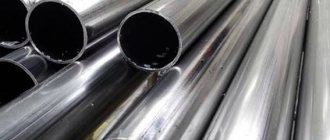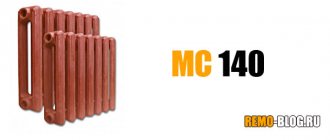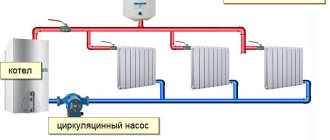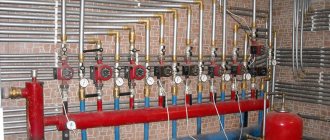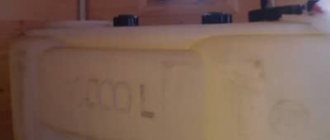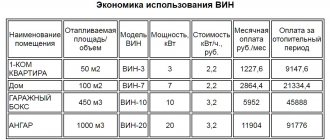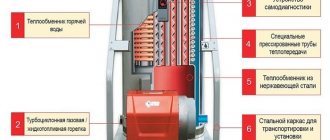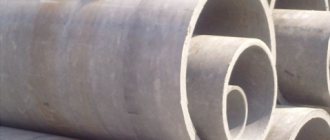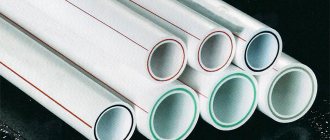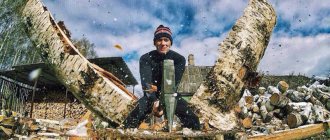Tips for choosing heating pipes for a private home by diameter
Getting to know the technical term “pipe diameter” begins with planning your home heating system. Usually there are no problems with choosing the type of pipeline, but difficulties begin with calculating the required diameter. You have to seek clarification and advice from experienced engineers - plumbers or specialists who practice installation of autonomous heating.
However, it is not always possible to get an exact unambiguous answer - what pipe diameter is best to use for heating a private house. A brief overview of the article contains the necessary information on how to independently calculate the diameter of the pipes for efficient operation of home heating.
Main criteria for choosing pipes
The thermal capacity of an autonomous heating network depends not only on the brand of the boiler brand and the length of the radiator batteries, but also on the type of material of the pipeline fittings.
Pipes for individual heating should be selected according to the following criteria:
- Accounting for the type of pipeline laying. Installation of the distribution line is carried out in an open and closed (built-in) way, and in case of repair, the damaged area can be replaced without any particular difficulties. The closed method is used for a “warm floor” heating system or when, according to the aesthetic requirements of interior design, the piping needs to be “hidden” in the wall or floor structure.
- Type of heating network. This can be an autonomous heat source or a centralized heating main with forced or natural coolant circulation.
- Indicator of the maximum coolant temperature. In regions with harsh climatic conditions, the heating circuit is designed for the maximum coolant temperature.
Pipe configuration. The heating system of a house with heating laid in one line sequentially from one heating device to another is called single-pipe. The two-pipe configuration involves laying heating pipes to the radiators of each room or room. The second configuration allows apartment residents to independently turn off heating devices in each specific room.
According to these basic rules, the type of heating pipe is chosen for each specific private house or apartment.
Features of installation of heating systems
In heating systems, there is a greater likelihood of pressure surges, so their installation requires great care and precision in the work. The technology for soldering polypropylene and crimping cross-linked polyethylene pipes with fittings must be strictly followed. Welding stainless steel and copper also requires special care.
When installing a one-pipe heating system, radiators should be connected parallel to the main line (using tees), and not in series (using corners). When switched on sequentially, the temperature of the coolant in each subsequent battery will drop very quickly, and the last rooms will always be cold.
When laying lines through walls and ceilings, it is necessary to do so in sleeves made of larger diameter tubes - the temperature of the coolant can reach 90°C or more, and this temperature can damage some types of building materials. The pipeline must move freely in the sleeve.
It is necessary to pay attention to the fastening of pipelines to the walls, otherwise the structure may fail. If a straight pipeline with a length of more than 10 m is laid, a compensator is installed - a special loop to compensate for thermal expansion. You cannot lay lines with a diameter that is too small - the boiler pump simply will not push the coolant.
Copper structures cannot be used with aluminum radiators - electrochemical corrosion occurs, which will lead to a rapid leak.
When choosing a coolant, you should take into account that ethylene glycol is extremely toxic and, if leaked, can harm human health. It is better to use a special antifreeze based on propylene glycol. Good antifreezes are expensive, and they should only be used in rare cases: for example, at a dacha that you visit only on weekends, or in a garage.
The influence of pipe type and size on system performance
The efficient operation of autonomous heating largely depends on the correct choice of the cross-section of the heating line. The throughput of the pipeline depends on this indicator. This characteristic shows how much hot water at a constant coolant speed will pass in one unit of time. In heating circuits, with constant fluid flow and a decrease in the diameter of the line in the communications, the speed of fluid movement increases. An example would be a home heating network with a boiler equipped with a pump with forced circulation of heated water. In this case, the coolant flow rate increases in sections of the line with a small diameter. In sections of the system with pipes of greater lateral decline, the speed slows down.
When the rate decreases below 0.25 m/sec, there is a risk of air jams forming in the system; a speed rate higher than the standard one leads to noise in the system.
The roughness of the internal cavity of the pipes has a great influence on the speed of movement of the coolant, as well as on the reduction in pressure. For example, we can compare the performance of two types of materials: the roughness of a new steel pipe with a diameter of 50 mm is 0.1 mm, and that of polymer products of the same diameter is 0.005 mm. The speed of fluid movement through new steel pipes f * 50 mm is 0.7 m/sec , for polymer pipes this figure is 22 m/sec.
Metal-plastic heating pipes
Metal-plastic pipes are universal - they are used not only in heating, but also in cold and hot water supply. The pipe has a layer-by-layer structure, consisting of three layers - internal, reinforcing and external.
The inner layer is made of polyethylene, the reinforcing (middle) layer is made of aluminum, and the outer layer is made of polymer. The reinforcing layer performs several important functions:
- Gives strength simultaneously with fixed ductility;
- Protects against diffusion penetration of oxygen;
- Significantly reduces the degree of linear expansion.
The outer coating reacts negatively to ultraviolet rays and gradually deteriorates. Therefore, external installation without protection is not recommended. The inner surface is smooth and not prone to deposits.
Pipes are produced in coils with a length of 50 m. The operating temperature is up to 950C (short-term - 1100C), pressure - up to 10 kgf/cm2. At temperatures above 1400C, the pipe delaminates and collapses. The lower the operating temperature, the longer the service life of the product. The declared service life is 30 years.
The connection of metal-plastic pipes is made by two types of fittings - compression (threaded) and press. Press fittings subsequently become non-separable. The main material of the fittings is brass; there are rubber seals. Installation of pipes of this type is simple and easy, but to press the fittings you will need a special tool - pliers. The flow area of brass fittings is slightly smaller than the cross-section of the pipe.
Pipes of the described design have low thermal conductivity and do not require thermal insulation. The disadvantage of metal-plastic pipes is the high cost of fittings and their high hydraulic resistance.
Types of heating pipes: pros and cons of the material
Modern autonomous heating systems are installed from metal or plastic pipes. The term “metal” combines several types: steel, stainless steel or copper. The category of plastic pipes is more extensive; they are made of polypropylene, metal-plastic and cross-linked polyethylene.
Table 1. Comparative performance characteristics of the main types of heating pipes.
| Material | Coolant temperature, degrees C | Roughness, mm | Pressure loss, Pa/m | Linear expansion, mm/m2*deg |
| Steel | Not limited | 0,07 | 5 | 0.012 |
| Metal-plastic | 95 | 0,004 | 1,5 | From 0.025 to 0.03 |
| Polyethylene | 90 | 0,007 | 1,8 | From 0.15 to 0.17 |
| Polypropylene | 70 | 0,01 | 2,0 | From 0.15 to 0.17 |
Hardware
Several decades ago, almost all heating systems of multi-story and private houses were equipped with metal pipelines. The following types of materials were used for manufacturing:
- Steel products made of ferrous or galvanized metal. Due to the excellent strength and high resistance of the metal to mechanical external damage, the service life of the heating network reaches 20 years. Steel pipes have no restrictions on coolant temperature. Therefore, they were often used for steam heating, in which the temperature reaches 100 - 130 degrees. For steel heating routes, the maximum pressure is 30 atmospheres. Main disadvantages: susceptibility to corrosion, large mass of products, the need to weld joints, high thermal conductivity, internal roughness.
Polymer pipes
Currently, heating pipes made of polymers are beyond competition. They replace outdated steel pipelines and are used for laying new heating networks in multi-storey buildings, private houses and apartments.
Various modifications of polymer products are used in heating systems:
Cross-linked polyethylene. The main advantage is the thermal stability of the material, the strength of the joints, and the low coefficient of hydraulic losses. For heating, products with internal reinforcement are used, which retain the original shape of the pipe during prolonged exposure to a high-temperature coolant. A big plus of polyethylene communications is that installation is carried out without special tools and equipment.
Metal-plastic. The pipe modification is distinguished by a multilayer structure of two layers of cross-linked polyethylene, an adhesive shell and an aluminum insert. Due to this design feature, high resistance to high temperatures of heated water is achieved, it becomes possible to bend the metal-plastic pipe in any direction, and therefore reduce the number of connecting fittings.
Polypropylene. The main limitation of such pipes is that they can withstand coolant temperatures of up to 70 degrees. A significant coefficient of thermal linear expansion in a complex with high fluidity of the material leads to sagging of the line and its deformation. Therefore, polypropylene pipes require the installation of additional fasteners. The main advantages are ease of assembly and low cost of material.
Table 2. Main differences between polymer heating pipes.
| Technical indicators of polymer pipes | XLPE pipes | Polypropylene pipes | Metal-plastic |
| Cost 1 running. meter and connecting fittings | average cost | Lowest cost | The most expensive option |
| Ease of installation | Installation with special sleeves and fittings | Installation using special welding equipment | Coupled joints or permanent press fittings |
| Types of standard sizes | From 12 to 25 mm | Large selection of standard sizes | Diameters up to 50 mm |
| Linear elongation rate | At maximum media temperature, 1 meter of pipe is lengthened by 2 mm | High linear elongation coefficient. The exception is reinforced pipes - 0.26 -0.3mm/m | No more than about 25 mm/m |
| Thermal stability | From 50 to 100 degrees. | Up to 120 degrees. | 95 degrees |
| Flexibility | When heated, the pipes bend well | Flexibility is minimal. Corner fittings and bends are required for line turns and bends | Good flexibility |
| Standard service life | Up to 50 years old | At least 25 years | From 15 to 25 years |
| Freeze resistance system | Multiple defrost cycles | Multiple defrost cycles | Up to 3 cycles |
Steel pipes
Steel is a material that is being used less and less for heating systems. The fact is that although steel pipes are strong and of high quality, they are subject to corrosion . Installation of heating systems made of steel pipes is a rather complex and labor-intensive process that only a professional can handle with the necessary equipment.
Due to high pressure losses and roughness, the use of steel pipes will lead to the formation of salt and biological formations inside them, which will reduce the flow of the pipes.
Steel pipes can easily withstand temperature changes and do not deteriorate or deform under the influence of hot water.
Advice . Steel pipes must be used where it is difficult to control the heating of the coolant and if a high temperature of the coolant is noticed.
Optimal size, temperature and pressure
In a private house, heating elements are connected using pipes of various diameters. As an example, we can consider products made from propylene, as the most popular material for creating a home heating system.
To find out what diameter of polypropylene pipes is needed for heating a private house, you need to consider the following recommendations:
- 16 mm pipes are recommended for laying a line to one or two radiators.
- 20 mm - used for a group of radiators with a total power of up to 7 kW.
- 25 mm - connect from 5 to 8 units of radiators with a total thermal power of 11 kW.
- 32 mm – connects one floor or an entire house with 12 radiators with a thermal power of up to 19 kW.
- 40 mm – to create a heating network for a private house with 20 radiators (30 kW)
The average temperature of the medium in an autonomous heating system ranges from 30 to 90 degrees. When the outside temperature fluctuates, the water heating is adjusted taking into account the creation of comfortable conditions in the room.
XLPE pipes for heating
Cross-linked polyethylene, unlike HDPE and LDPE (low- and high-density polyethylene), has elevated temperature characteristics and is not destroyed by ultraviolet radiation. This is due to the presence of an increased number of bonds (cross-linking) in the structure of the material.
The degree of cross-linking of the material has different values (from 60%), the technical parameters of the product directly depend on it. The operating temperature is stated at 900C, while the operating pressure of the coolant should not exceed 6 kgf/cm2 (at 800C - 8 kgf/cm2, at 700C - 10 kgf/cm2). The nominal pressure is 16 kgf/cm2. The pipe can be single-layer or multi-layer. The pipe has the maximum thermal expansion among all polymer products. To reduce the amount of thermal expansion, aluminum-reinforced products are produced.
The assembly of cross-linked polyethylene networks is carried out using compression and press fittings (press, crimp) fittings made of brass or high-strength plastic. This type of pipe is most applicable in autonomous heating systems that have a low operating temperature, in low-temperature water-heated floor systems.
All polymer pipes usually do not require thermal insulation, are not subject to the formation of deposits, and have a high level of noise insulation. The cost of the material is lower than the price of metal products. You can almost always do the installation of all plastic pipes yourself.
The choice of pipelines for heating systems is important from the point of view of maximum service life, good reliability and hydraulics, and low cost. Here you can highlight the most expensive and reliable pipes - copper and stainless steel, the middle segment - almost all polymer (plastic) pipes, and the weakest option - simple steel.
( , 7 today)
Boiler and circuit power
In private houses or apartments, heating of the interior is carried out by gas or electric boilers.
The calculation of the required thermal power is carried out depending on the size of the heated area. It is believed that high-quality heating of 1 m2 will require 0.1 m kW of thermal energy. Depending on climatic conditions and gentle operating conditions, this figure increases to 1.3 kW/m2. Factors affecting the power of a heating boiler:
- Type of building material for the enclosing wall structures of a house. The high thermal conductivity of the material in combination with the insufficient thickness of the external walls greatly increases heat losses and then the operation of the boiler with the highest power will be inefficient and unsatisfactory.
- Using a second circuit to heat water. If such an option is provided in advance, a more powerful heat generator is selected.
- Type of fuel. A gas boiler is considered more economical, but it can only be used in areas where there is a gas pipeline.
Water circulation in the system is ensured by a pump designed to optimize the speed of hot water and its return. At the same time, the problem of air pockets squeezed out by a constant flow of coolant is solved.
Source
Which pipes are best to choose for heating: a comparative review
The question of which heating pipes are better comes up during the construction or major renovation of private residential real estate. Owners of houses and apartments ask it to consultants in construction stores, installation engineers and employees of repair teams, but do not receive a definite answer.
This is an objective reality, because Modern heating systems differ significantly from each other and require individual selection. We will introduce you to all types of pipes currently used in pipeline construction. Taking into account our recommendations, you can choose the best option.
Main criteria for choosing pipes
To wisely and correctly select pipes for your home heating system, consider the following items:
- type of installation of the pipeline complex - surface or hidden (internal);
- estimated pressure power - assessment of the range from basic to maximum possible indicators;
- type of heating system - autonomous or central communications with gravity or forced circulation of the heating composition;
- the maximum temperature for which the coolant is designed;
- configuration features of heating equipment - single-pipe or two-pipe complex.
Only by knowing all these factors can we begin to select the type of material that will perform most effectively under specific specified conditions.
Varieties for heating systems
Modern heating systems use rolled pipes and parts made of materials such as metal or plastic. The first category includes ordinary steel, alloy steel and copper pipes. The second includes polypropylene, metal-plastic and polyethylene cross-linked communication elements.
They all have certain positive qualities and manifest themselves effectively in different situations. The choice of a specific type of pipe is made individually, depending on the expected operating conditions and other important parameters.
Features of steel pipes
Until recently, steel pipes were used in the vast majority of heating systems and were the only material available. Today their positions have significantly weakened, and serious competitors have appeared nearby.
However, it was not possible to completely oust steel pipes from the market. Until now, they have been successfully used, but mainly in autonomous gravity-flow complexes, where the laying of large-diameter communications is required.
Among the main advantages of steel pipes are a high tendency to thermal conductivity, low linear expansion during active heating, and resistance to intense pressure.
Justified advantages are considered to be unprecedented strength, both on straight and rounded sections, the ability to withstand aggressive temperature conditions and the affordable cost of elements.
Among the shortcomings, they point to problematic and labor-intensive installation, which is impossible without the presence of specialized expensive equipment, which can only be operated by professionally trained craftsmen with extensive experience in carrying out such activities.
The process of arranging a heating complex is also complicated by the impressive dimensions of the pipes. You won’t be able to do everything alone; it’s better to involve one of your friends or relatives who has the skills of welders and installers. It’s easier and faster to work with a team; everything can be organized clearly and accurately, ensuring the system has the necessary tightness.
Steel pipes and steel fittings used to connect them are absolutely not suitable for organizing hidden heating systems. The metal has a low anti-corrosion threshold and in humid conditions quickly rusts, rots and leaks.
To fix the problem, complete dismantling of the decorative covering is required if the pipe runs indoors, or large-scale excavation work when the problem arises on the approach to the house.
What is the difference between alloy steel?
Alloy steel is a durable material that, in addition to traditional impurities, contains various additives that improve the physical properties of the metal.
An example of an alloyed material is stainless steel - this is a special steel alloy containing at least 12% chromium. This additive ensures pipe resistance to corrosion and easy processing with special tools.
For the production of pipes with a welded seam, cold- or hot-rolled steel sheets with a working thickness of 0.4 - 5 mm and 2 -50 mm, respectively, are used.
Finished products have less weight than conventional steel ones and have good resistance to structural destruction and mechanical damage. Due to the low coefficient of thermal expansion, they can easily withstand severe temperature loads during operation. They function perfectly at pressures up to 16 bar.
Another indisputable advantage of alloyed stainless steel pipes is the ability to transport not only coolant heated to high temperatures, but even heated steam.
Types of stainless steel pipes
Alloy stainless steel pipes are made in two ways: welded and seamless. In the first version, sheets of metal are connected to each other using electric welding, producing a longitudinal or spiral seam. To prevent heat-affected corrosion, the joint area is subjected to special treatment and grinding.
Seamless products are made by cold or hot deformation of solid pipe blanks made of stainless alloy steel. The cold method produces thin-walled pipes, and the hot method produces thick-walled pipes. The finished product has a perfectly smooth surface and is characterized by unprecedented reliability.
Pipes made using seamless technology are not afraid of corrosion, function perfectly in harsh and aggressive operating conditions and can easily withstand record temperatures and enormous pressure.
Copper pipes for heating
In the manufacture of pipes for heating systems, high-quality copper is used, and in rare cases, a copper-zinc alloy, where the volume of the zinc component does not exceed 5%. To reduce the level of heat loss and give the products a more attractive appearance, the outer surface is covered with a polyethylene or polyvinyl chloride layer.
Among the main advantages of the material for copper pipelines, the unsurpassed strength is first noted, thanks to which the products last for 100 years during intensive use and are not subject to corrosion.
Their thermal conductivity is 389.6 W/mK, which significantly exceeds the actual performance indicators of cast iron, steel and metal-plastic.
The operating temperature range of copper pipes is very wide. They perform well both at high (up to +250°C) and low (up to -100°C) temperature conditions, do not melt during intense heating, do not crack or deform during operation.
The thermal expansion rates of copper pipes are simply minimal. With regular exposure of metal to a coolant temperature of more than 90°C, each linear meter of communications lengthens by approximately 0.1%. All other materials here are significantly inferior to copper.
Due to the ability to maintain an aesthetic, attractive appearance over time, they are suitable for laying pipelines of not only internal, but also external heating systems and can serve not only for their intended purpose, but also serve as a decorative interior element.
Among the disadvantages, professionals note incompatibility with other metals. In order to reduce the cost, it is not recommended to use connecting parts made of cast iron or stainless steel for copper pipes. Such “savings” will subsequently backfire on the owner, since the chemical reaction between the elements will ultimately provoke corrosion of the entire heating system.
In the assembly of copper pipelines, only copper fittings are used. They are used to make connections by crimping, high-temperature and low-temperature soldering.
Among the disadvantages of copper pipes, their high cost is most often mentioned in comparison with other types of materials.
Distinctive features of polypropylene products
Polypropylene is a rigid, non-toxic synthetic polymer with high physical and mechanical characteristics. Pipes made from this modern material demonstrate exceptional impact resistance and multiple bending capabilities, low gas and vapor permeability, wear resistance and complete dielectricity.
Advantages of PP material
Thanks to these qualities, PP pipe material is actively used for arranging heating systems both on an industrial scale and in the private sector.
Polypropylene pipes are included in the category of budget communication parts and are lightweight, making them easy to transport and install alone.
Other advantages include the following:
- a perfectly smooth inner surface that does not contribute to the accumulation of lime deposits, which significantly complicate the free circulation of the coolant;
- quick and affordable installation that does not require the use of expensive professional equipment (all work can be done using a soldering iron, which is so easy to use that even a person very far from such work can easily “obey” it);
- long service life without loss of efficiency (on average about 25 years at full load);
- good resistance to negative temperatures;
- neat, aesthetic appearance that does not deteriorate over time.
The disadvantages of polypropylene pipes include the weak rigidity of the plastic, which in the future can cause sagging of the heating main and, as a result, lead to a crack in the joint or breakage.
To fix the problem, simply patching the fragment will not work. For subsequent correct operation and restoration of the integrity of the heating complex, it will be necessary to replace the section of pipe located between the two fittings.
The parts of a polypropylene pipeline are connected by welding, the specifics of which are described in the article we recommend.
You can also familiarize yourself with the features of choosing a welding machine for constructing a polypropylene pipeline and the recommended operating temperature limits for soldering on our website.
Types of polypropylene pipes for heating
In order for a home heating system to work longer and demonstrate the highest possible efficiency levels throughout the entire operational period, reinforced polypropylene pipes are used. They are classified according to the type of reinforcing material.
The PP pipes used in the heating device are reinforced with aluminum foil along the outer layer, in the middle or along the inner edge. In this case, sheets of metal can be discontinuous, solid or corrugated.
The foil reduces the actual thermal expansion of the material and creates a diffusion barrier, preventing oxygen from penetrating the walls. As a result, calcium sediment does not form and does not provoke oxidation processes on the walls of the radiators and boiler.
Fiberglass is also an effective reinforcing material for pipes. By coextrusion, it is placed in the middle layer of a polypropylene pipe. Due to the fact that both materials are similar in composition and basic properties, during welding with a fitting, a high-strength alloy is formed that is not subject to delamination even during long-term operation.
Polypropylene pipes with fiberglass reinforcement are simple and easy to install, unlike aluminum pipes, they do not require additional cleaning of the edges before soldering, and demonstrate excellent sound insulation properties.
Another modern reinforcing element is composite. It is a mixture of polypropylene and fiberglass. Added to the pipe, it increases the adhesive properties of the reinforcing layer and enhances performance characteristics such as strength and resistance to mechanical damage.
Rules for assembling pipelines for heating systems made of polypropylene pipes are given in the following article, the contents of which we advise you to familiarize yourself with.
XLPE pipes
Cross-linked polyethylene is a progressive material made using modern technologies. It is a polymer of ethylene with molecules connected cross-linked by chemical or physical cross-linking. It has a homogeneous structure, flexibility and a high level of tensile strength.
The list of main advantages of cross-linked polyethylene pipes includes:
- excellent shrinkage properties;
- the ability to clearly hold its shape along the stitching line even when heated to 200 C°;
- excellent wear resistance during intensive use;
- absence of halogens and heavy metals;
- immunity to corrosion and high pressure;
- low vulnerability to chemically active aggressive substances;
- normal impact strength at low temperatures (down to – 50 C°);
- minimum percentage of expansion under the influence of heat;
- suitable for hidden installation;
- minimal need for preventative maintenance.
Due to its plasticity, the material can be easily processed and does not require special tools, special professional abilities or serious experience. Even an amateur can handle installing a heating system if he has step-by-step instructions on hand to describe the necessary work.
The most significant disadvantage of cross-linked polyethylene is its high vulnerability to ultraviolet radiation and the objective technological impossibility of producing large-diameter pipe material.
Methods and technology for welding polyethylene pipes are described in an article entirely devoted to this interesting issue.
Metal-plastic for pipeline construction
Metal-plastic products are the most common and practical material for arranging home heating systems. They harmoniously combine the advantages of plastic and metal, only absorbing the disadvantages of both materials to a minimum.
Metal-plastic pipes have a complex design and multi-level structure. The outer plastic layer acts as a fuse and protects the product from aggressive environmental influences. Next are aluminum foil and a polymer of increased smoothness, which prevent sediment and deposits from accumulating inside.
The connection of metal-plastic pipes is made using specialized fittings designed for crimping and clamping. In the first case, theoretically detachable connections are created, which are still not recommended to be disassembled unless absolutely necessary. In the second - one-piece.
No expensive tools are required to form connections with press fittings. The article we recommend for reading will familiarize you with his choice. The system can be assembled by a completely inexperienced performer.
Of the distinctive features of metal-plastic pipes, the most important are:
- minimal linear expansion under the influence of the coolant, which does not lead to deformation and sagging of the pipeline system or its individual fragments;
- pronounced smoothness of the inner surface, due to which the passage does not become clogged and the coolant circulates as expected; good temperature resistance (lower than metal parts, but higher than other plastic products);
- bending and tensile strength, ductility within acceptable radii (if the threshold is exceeded, “breaking” is possible);
- light weight, greatly facilitating the installation process;
- corrosion resistance;
- possibility of processing without the use of special equipment.
The disadvantages include the not very long service life of pipe products (up to 15 years according to manufacturers) and the significant cost of connecting fittings.
Copper pipes for heating
Copper pipelines are known for their high performance:
- Service life – more than 80 years;
- Thermal resistance – from – 150 to +2500С;
- Strength – withstands pressure up to 45 – 55 kgf/cm2;
- Resistance to corrosion and most other negative factors.
Copper pipes are divided into 2 main types:
- Unannealed;
- Annealed.
Unannealed pipe has no plasticity and is produced in sections of different lengths. Due to heat treatment, the annealed pipe loses some strength, but acquires high flexibility and ductility.
Pipelines are connected using two methods - soldering with special solder and using compression copper (or brass) fittings.
These types of copper pipes are universal for use in heating systems of any type. The pipe is not prone to deposit formation.
The cost of copper pipes is high - from 200 rubles and more per 1 meter. Installation also has its difficulties - while compression fittings can be installed independently, soldering requires equipment and a decent level of experience.
All metal pipes have a high degree of thermal conductivity of the material, so measures for thermal insulation of communications are often required.
